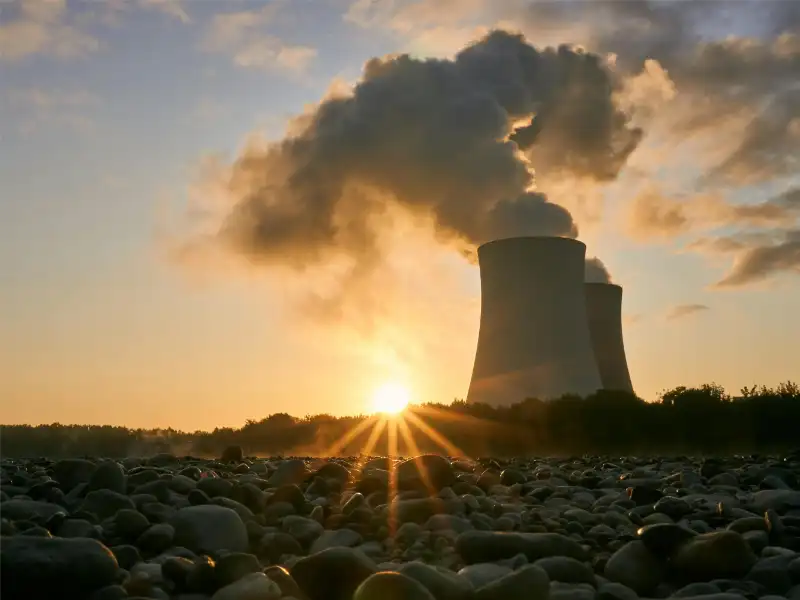- The United States was one of the first countries to adopt nuclear power technology, beginning in the 1950s. Significant investment was made in developing nuclear energy as a part of the country’s strategy for securing an independent and reliable energy source.
- Post-World War II America experienced significant economic growth and industrial expansion, which drove a massive increase in energy demand.
Nuclear power plants operate in 32 countries, generating approximately one-tenth of the world’s electricity. The majority are located in Europe, North America, and East Asia. The United States leads as the largest producer of nuclear power, while France boasts the highest share of electricity generated by nuclear power, accounting for around 70%.
Why America leads in nuclear power plants
The United States leads the world in the number of nuclear power plants due to a combination of early adoption and significant investment, a high demand for energy driven by economic growth, and strong policy and regulatory support.
Early adoption and investment
The United States was one of the first countries to adopt nuclear power technology, beginning in the 1950s. Significant investment was made in developing nuclear energy as a part of the country’s strategy for securing an independent and reliable energy source.
The government provided substantial funding for research and development, leading to rapid advancements in reactor design and safety. This early adoption and commitment to nuclear power set the stage for the U.S. to build a large number of plants, establishing itself as a leader in nuclear energy from the start.
Also read: Micro nuclear power: Interview with Bret Kugelmass, CEO of Last Energy
Energy demand and economic growth
After World War II, America experienced significant economic growth and industrial expansion, which drove a massive increase in energy demand.
Nuclear power was seen as a ready-made panacea to meet this demand due to its ability to produce large amounts of electricity without relying on fossil fuels. The need for a stable, high-capacity energy source to support industrial activities, growing urban centres, and technological advancements spurred the construction of numerous nuclear power plants across the country. This growth trajectory necessitated a diversified energy portfolio where nuclear power played a crucial role.
Also read: Hybrid quantum-classical computing simulates neutron scattering
Policy and regulatory support
The U.S. government established a regulatory framework that supported the expansion of nuclear power through agencies like the Atomic Energy Commission (AEC) and later the Nuclear Regulatory Commission (NRC). These entities provided oversight, ensured safety standards, and facilitated licensing processes for new plants.
Additionally, policies such as the Price-Anderson Act limited the liability of nuclear operators in case of accidents, reducing financial risks. Such supportive legislative and regulatory environments encouraged private sector investment and innovation in nuclear technology, leading to the proliferation of nuclear power plants nationwide.
Global trends in nuclear power
Phase-outs and discontinuations
Some countries operated nuclear reactors in the past but currently have no operating nuclear power plants.
Among them, Italy closed all of its nuclear stations by 1990, discontinuing nuclear power following the 1987 referendums.
Kazakhstan phased out nuclear power in 1999 but plans to reintroduce it possibly by 2035.
Germany operated nuclear plants from 1960 until the completion of its phaseout policy in 2023.
Never-commissioned plants
Zwentendorf nuclear power plant in Austria and the Bataan nuclear power plant in Philippines never began using their fully constructed first nuclear plants.
Sweden and Belgium initially had phase-out policies but have since moved away from their original plans.
The Philippines relaunched its nuclear program on February 28, 2022, and may attempt to operate the mothballed Bataan Plant from 1984.
New developments and future plans
As of 2020, Poland was in the advanced planning phase for a 1.5 GW nuclear plant and planned to have up to 9 GW by 2040.
Hong Kong has no nuclear power plants within its borders but imports 80% of its electricity from the Daya Bay Nuclear Power Station across the border, in which a local power company holds a stake.
In 2021, Iraq announced plans to build 8 nuclear reactors by 2030 to supply up to 25% of its electric power in a grid suffering from shortages.
Technological advancements
Some countries are revisiting or expanding their nuclear energy capabilities due to the need for reliable, low-carbon energy sources amid growing concerns over climate change and energy security. Introduction of new technologies such as Small Modular Reactors (SMRs) and advancements in reactor safety and efficiency are shaping the future of nuclear power.

